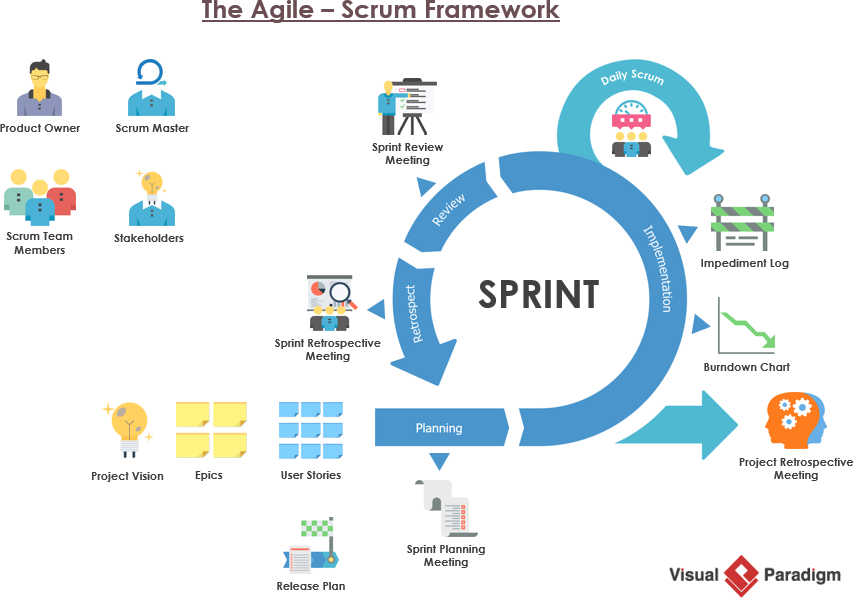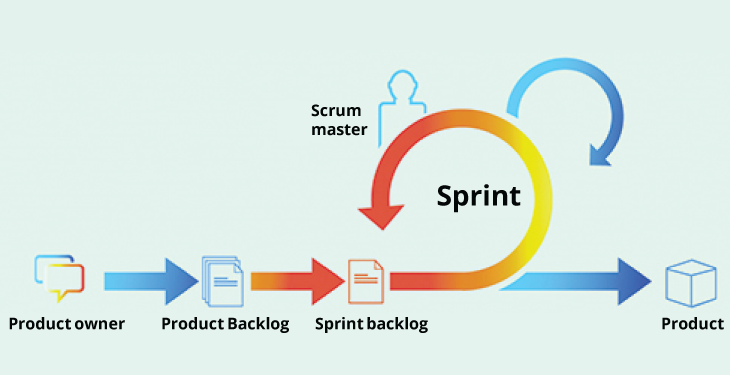As a technology and management consulting firm, Transforming Solutions implements a variety of project management tools when consulting with clients on a variety of topics: business process improvement, software evaluation and selection, technology assessments, among many others. In fact, not having a project management framework in place could be a reason why projects fail.

Scrum is an agile way to manage a project, usually software development. Agile software development with Scrum is often perceived as a methodology; but rather than viewing Scrum as methodology, think. Scrum is a framework that is used to implement Agile development. A good analogy would be the difference between a recipe and a diet. A vegetarian diet is a set of methods and practices based on. In predictive management it is primarily the Project Manager who is responsible for tracking against the plan. This may be a tracking Gantt chart, with exceptions escalated. The Project Manager is the role.
TSI prides itself on adapting and pivoting to meet client needs by implementing Scrum project management, when appropriate. Scrum project management is an agile approach often used with software evaluation and selection projects that incorporates interactive practices and small wins to reach the end goal. It uses a set of resources, meetings, and roles that help teams manage and plan their work.
In this blog, we will describe the following Scrum project components:
- The Scrum framework
- Key Scrum roles in a project team
- Scrum deliverables/artifacts to use during a project to stay on target
The Scrum Framework
Going back to school is to a growth mindset as the scrum framework is to an agile mindset. The scrum framework is based on continuous improvement and incremental growth, and it allows a project team to change directions and change where needed. Scrum is structured in small sprints to help project teams adjust to changes flexibly and re-prioritize tasks as needed. These sprints are typically between 2 weeks and 1 month long, but these timelines are flexible and your team can change sprints at any time.
Each Scrum sprint will have 4 main components:
- Sprint Planning Meeting: This meeting should take place at the start of each project sprint and should outline what activities should be completed and milestones should be met within the current sprint. This meeting allows the team to discuss high and low priorities and discuss tasks to be completed during the sprint. It is also an opportunity to look at the project holistically and begin working backwards to accomplish tasks.
- Daily Scrum Meetings: Many teams find value in hosting brief (15 minutes or less) daily meetings to discuss yesterday’s progress, today’s goals, and identify any risks or disruptions that may cause today’s goals from being accomplished. This is an opportunity to get the team energized for the tasks ahead!
- Sprint Review: This meeting is set to demonstrate what has been accomplished during the sprint and get feedback from key stakeholders regarding what needs to change going forward, review milestones that weren’t met, and determine how to achieve those milestones.
- Sprint Retrospective/Reflective: At the end of each sprint, the project team meets to reflect on tasks and activities, and determine opportunities for improvement in the upcoming sprint. This is an opportunity to update any project management documents and finalize any deliverables from this sprint.
Key Scrum Roles

Below are some of the key roles within a Scrum project team:
Product Owner/Product Manager Role in Scrum)- A product owner is the individual on the project team who defines the features, scope and schedule of the project. This individual is responsible for overseeing and achieving the financial goals of the project, and they also prioritize the product backlog and adjust the priority of backlog tasks as needed. The Product Owner’s job is to make the project vision a reality.
Scrum Project Management Certification
ScrumMaster- The ScrumMaster is the individual responsible for enacting and enforcing scrum practices. They coach the project team using Scrum values at the forefront of their methodology which helps improve team productivity. They are what some call a “servant-leader for the Scrum Team” (Scrum Guide). The ScrumMaster does not oversee the day-to-day activities of the project, but provides strategies to move the team forward. They help remove distractions, detailers, and disruptions from the project.
The Scrum Project Development Team- Scrum project teams are typically 5-9 cross-functional individuals, ensuring that the team has the necessary skill sets to accomplish tasks. Titles of team members do not matter, only the work being performed by each team member, and accountability belongs to the entire team, not just one person. This encourages a strong sense of teamwork and ownership among the whole team. As they say in High School Musical, “we’re all in this together!”
Scrum Deliverables/Artifacts
Product Backlog- A Product backlog is a list of all desired work and tasks for a project. It serves as the single source of truth for all project activities and includes a list of details, estimates, and priority values. A priority value is assigned by the Product Owner at the beginning of a project, but this value is subject to change at the beginning of each sprint as tasks are added or priorities shift.
Sprint Backlog- A Sprint Backlog is a micro-set of a Product Backlog. It is a set of items selected for a particular sprint and includes all of the work needed to meet the sprint goals. Members of the project team sign up for their own tasks to complete, and estimated remaining work is updated daily in this document. The Sprint Backlog is a collaborative, iterative document that is constantly being changed and updated by the project team.
Burndown Charts– These charts show a visual presentation of work that still needs to be completed in a sprint, compared to the timeline and plan of work.
TSI implements iterative deliverables (pre-final recommendations and deliverables) whereby we collaborate with the project team by presenting recommendations in phases that are shaped via input by key stakeholders. Phil Jackson once said, “The strength of the team is each individual member. The strength of each member is the team.”
How to get started
Scrum can seem overwhelming. There are constantly moving parts, changes that need to be implemented swiftly, and roles that need to be determined. There is always more work to be completed. However, the goal of Scrum is to accomplish the work in a smarter, more iterative way.


Are there any current or upcoming projects that would benefit from implementing the Scrum framework? Not sure how to get started? Transforming Solutions is ready to help. Email us at tsi@transforming.com to learn more about our project management services.
Scrum Project Management Methodology
Improve Your Capabilities as a Professional
Scrum.org training classes are consistently led by Scrum.org expert Professional Scrum TrainersTM (PSTs) to foster experiential learning though instruction, exercises, group activities, real-world examples and discussion, all based on a set of Professional Scrum Competencies. Our training materials are created and maintained by Scrum co-creator Ken Schwaber, Scrum.org and the PST community members who teach the courses, helping to ensure that they are in tune with what’s happening in organizations and always up-to-date with the latest practices. Scrum.org has trained over 244,000 students around the globe.
Professional Scrum Trainers
Scrum Project Management
Professional Scrum Trainers bring their own style and experience to the courses, but use the same materials so that students are learning from the same content regardless of who teaches the course or where it is taught around the world. The result is a tremendously mature and capable set of training materials combined with Scrum experts who work together to realize our shared mission of helping people and teams solve complex problems.
Certification and Assessments

Best wifi password hacking software. Each class includes a free attempt at the corresponding certification assessment. In your Professional Scrum class, you will learn the importance of inspection, adaptation, and fast feedback cycles. To reinforce those concepts, if you take a Scrum.org class and attempt the certification assessment within 14 days and do not score at least 85%, you will be granted a 2nd attempt at no additional cost.
The assessments are decoupled from the classes and delivered in an electronic form. The decoupling of assessments from training not only ensures an objective measurement for the student, it also allows students to be assessed on their incoming knowledge and experience, and allows Scrum.org to gather feedback to fine tune training materials and their delivery.
What Makes Scrum.org Training Different?
- Consistent - Professional Scrum Trainers (PSTs) bring their own style and experiences with a consistent delivery of Scrum.org training around the world, so you know each course we teach is aligned with Scrum, and all of your teammates are learning from the same message.
- Global - Scrum.org 340+ Professional Scrum Trainers are spread globally around the world.
- Quality - Scrum.org PSTs are a select group of Scrum experts who go through an extensive set of peer reviews, testing, training, and interviews prior to being accepted as a PST. Each individual PST must be certified and licensed to teach Scrum.org training. All trainers do more than teach, they spend time on Scrum Teams so that they bring experience to their teaching and understand how to deal with situations in the real-world.
- Experienced - Professional Scrum Trainers bring current agile practices and real-world Scrum experience to the classroom, as PSTs spend a significant amount of their time working on projects. All PSTs must stay up-to-date through annual face-to-face trainer meetings and support of the community.
- Innovative - All training materials are collaboratively maintained and improved by our community of Scrum experts and our founder Ken Schwaber, the co-creator of Scrum.
- Certification - All training classes come with the globally recognized Professional Scrum assessment attempt.
- Focused - Scrum.org training classes focus on delivering value and all exercises are designed around how a Scrum Team works to deliver value.
- Forever - Professional Scrum certifications are yours for life with no renewal costs to retain them.
- Competency Model Based - Each of the Scrum.org courses and broader role-based learning areas are based on a validated and proven competency model. Each competency has a set of Focus Areas that are used to drive an individuals learning and course material creation. View the competencies.
- Our Course Steward Model - Each Scrum.org course is assigned 2 stewards. The steward is ultimately responsible for collecting input on the course materials, both those that exist and potentially additions to be made, review that input with the community along with Ken Schwaber and provide updates as required.
Each course is stored in GitHub, allowing version control, feedback mechanisms, distribution and much more, not unlike the code that Scrum Teams deliver for their products. Through GitHub capabilities, a PST can submit feedback on a course materials, its delivery content, speaker notes, exercises and much more. With PSTs around the world teaching the materials, that provides a fantastic number of people to provide excellent feedback to improve the content and quality of the courseware.
What Our Students Say
PMI Course Credit
Scrum Project Management Tools
Students of Scrum.org courses are able to claim Project Management Institute (PMI) PDU credit: 14 PDUs after attending a two-day Applying Professional Scrum (APS), Professional Scrum Master (PSM), Professional Scrum Master II (PSM II), Professional Scrum Product Owner (PSPO) and Professional Scrum Product Owner Advanced (PSPO-A), Professional Scrum with Kanban (PSK), Professional Agile Leadership Essentials (PAL-E), or Scaled Professional Scrum (SPS) course and 21 PDUs after attending a three-day Applying Professional Scrum for Software Development (APS-SD) course. Please note that PMI PDUs are earned for course attendance and not for passing a Scrum.org assessment. Students can claim PDUs under PMI's 'Education courses provided by other third party providers” category. You can claim your PDUs online at https://ccrs.pmi.org.

Comments are closed.